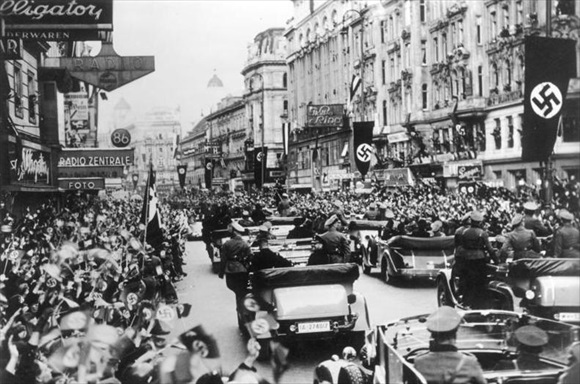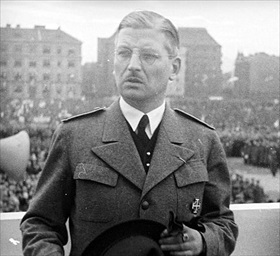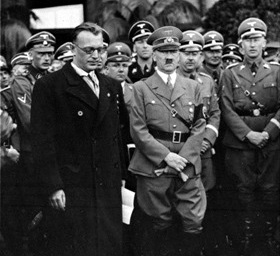HITLER INVADES AUSTRIA
Linz, Austria • March 12, 1938
After abolishing Germany’s Ministry of War on February 4, 1938, and creating in its place the Oberkommando der Wehrmacht (OKW, or Supreme Command of the Armed Forces) with himself at its helm, Adolf Hitler now focused on a peaceful takeover of Europe beginning with his native Austria, an Alpine country of 7 million German-speakers who shared borders with Germany (Bavaria) and Czechoslovakia to their north. (Hitler was born in Braunau am Inn near Linz, the Upper Austrian provincial capital.) In mid-February 1938 Hitler invited Austrian Chancellor Kurt Schuschnigg to meet him halfway, at the Berghof in Bavaria, the Fuehrer’s luxurious vacation residence. Schuschnigg wanted to use the meeting with his German counterpart to reaffirm Austria’s independence of its powerful neighbor. Hitler, in the company of 3 German generals (one being, in Hitler’s words, one of his “two most brutal-looking generals”), used the meeting to browbeat Schuschnigg into joining with him in creating a Greater German Reich (Grossdeutschland) through Anschluss (union) with Nazi Germany, an occurrence that incidentally had been expressly forbidden by the 1919 Treaty of Versailles that ended the war between Germany and the Allied powers. “Perhaps I’ll appear sometime overnight in Vienna; like a spring storm. Then you’ll see something,” he warned Schuschnigg.
The Austrian chancellor returned home more determined than ever to avoid a German embrace. Schuschnigg proposed a national referendum over the issue of Anschluss, to take place on Sunday, March 13, 1938. Hitler was afraid that the outcome of the vote would be unfavorable to pro-Nazi Austrians. Schuschnigg and his predecessor in office had jailed many Nazi enthusiasts, violently suppressed and outlawed the Nazi Party, and raised the voting age to 24 in order to prevent the younger generation, many of whom were closet Nazis pumped full of Nazi ideology, from voting in the national referendum.
On the eve of the referendum, Hitler sent a written ultimatum to the Austrian government, insisting that the March 13 referendum be cancelled and that Schuschnigg resign in favor of Austrian right-wing politician Arthur Seyss-Inquart, a secret member of the Nazi Party. To enforce Anschluss Hitler ordered German troops into Austria on this date, Saturday, March 12, 1938. That afternoon, accompanied by a 4,000‑man bodyguard, Hitler crossed the Austrian border at Braunau and made a triumphal entry into Linz, his “hometown,” later in the evening. Schuschnigg took to the national airwaves and, in a voice cracking, told his countrymen, “We have yielded to force . . . in this terrible situation.”
An ad hoc Einsatzkommando (task force) formed by Reinhard Heydrich, psychopathic chief of both the Sicherheitsdienst (SD), or Security Service, and the Sicherheitspolizei (SiPo), or Security Police, which comprised in part the notorious Geheime Staatspolizei (Gestapo, Secret State Police), secured Austrian government buildings and documents and interrogated senior civil servants. Schuschnigg was arrested and deported. (Schuschnigg spent most of the war years in 2 different Nazi concentration camps, first Sachsenhausen north of Berlin, then Dachau near Munich.) Austrian Nazis held a sham plebiscite the following month, asking voters to ratify the fait accompli. The electorate allegedly voted 99.73 percent in favor of Anschluss. Austria became known as Ostmark, “the Eastern Region.”
Though the great majority of Austrians were not card-carrying Nazis, support for Germany’s wartime policies remained popular until late in the war. Hundreds of thousands of Austrians fought in the German Wehrmacht (armed forces), while a good-size number served in the SS, short for Schutzstaffel, the elite military corps of the Nazi Party. By war’s end roughly 250,000 Austrians were dead or missing in combat. An even greater number of Austrians were held in prisoners of war camps. In addition, more than 20,000 Austrians died in Allied bombing raids. When Austria regained its independence in 1945, much of the nation’s infrastructure had been damaged or destroyed. In the postwar occupation period Austria ranked as one of the poorest in Europe.
German-Austrian Anschluss, March and April 1938
 |
Above: Hundreds of thousands of cheering Austrians lined the streets as Hitler and his entourage made a triumphal entry into Austria’s capital, Vienna, on March 14, 1938. Scarlet swastika flags hung from buildings, flew from car fenders, and fluttered back and forth in the hands of Viennese crowds. Columns of gleaming German limousines, motorcycles, armored cars, and trucks carrying thousands of men in field-gray uniforms converged on the city as if overnight.
 |  |
Left: Austrofascist chancellor of Austria (1934–1938) and Fatherland Front leader Kurt Schuschnigg at a party rally, 1936. Schuschnigg rejected Hitler’s Pan-German politics; instead, he focused on protecting Austria’s independence during a decade of political unrest in Central Europe. After the war and his release from German captivity, Schuschnigg emigrated to the U.S., where he taught political science at Saint Louis University in Missouri from 1948 to 1967. Schuschnigg returned to Austria where he died in 1977.
![]()
Right: Nazi Reich Governor Arthur Seyss-Inquart with Hitler in Vienna, March 1938. (Heydrich is behind Hitler and to his left.) During their February 1938 meeting at the Berghof, Hitler bullied Schuschnigg into appointing Austrian Nazi Party leader Seyss-Inquart to head Austria’s Ministry of Public Security, a sensitive post that gave Austrian Nazis full and unlimited control of their country’s police forces. With the assistance of Seyss-Inquart’s post-Anschluss puppet government, the Nazis quickly embarked on a campaign of repression and terror. Tens of thousands of Austrians, including Catholics, Social Democrats, Socialists, and Communists, were arrested and sent to concentration camps.
Nazi Germany and Hitler’s Entry into Austria, March 1938
![]()

 History buffs, there is good news! The Daily Chronicles of World War II is now available as an ebook for $4.99 on Amazon.com. Containing a year’s worth of dated entries from this website, the ebook brings the story of this tumultuous era to life in a compelling, authoritative, and succinct manner. Featuring inventive navigation aids, the ebook enables readers to instantly move forward or backward by month and date to different dated entries. Simple and elegant! Click
History buffs, there is good news! The Daily Chronicles of World War II is now available as an ebook for $4.99 on Amazon.com. Containing a year’s worth of dated entries from this website, the ebook brings the story of this tumultuous era to life in a compelling, authoritative, and succinct manner. Featuring inventive navigation aids, the ebook enables readers to instantly move forward or backward by month and date to different dated entries. Simple and elegant! Click 











